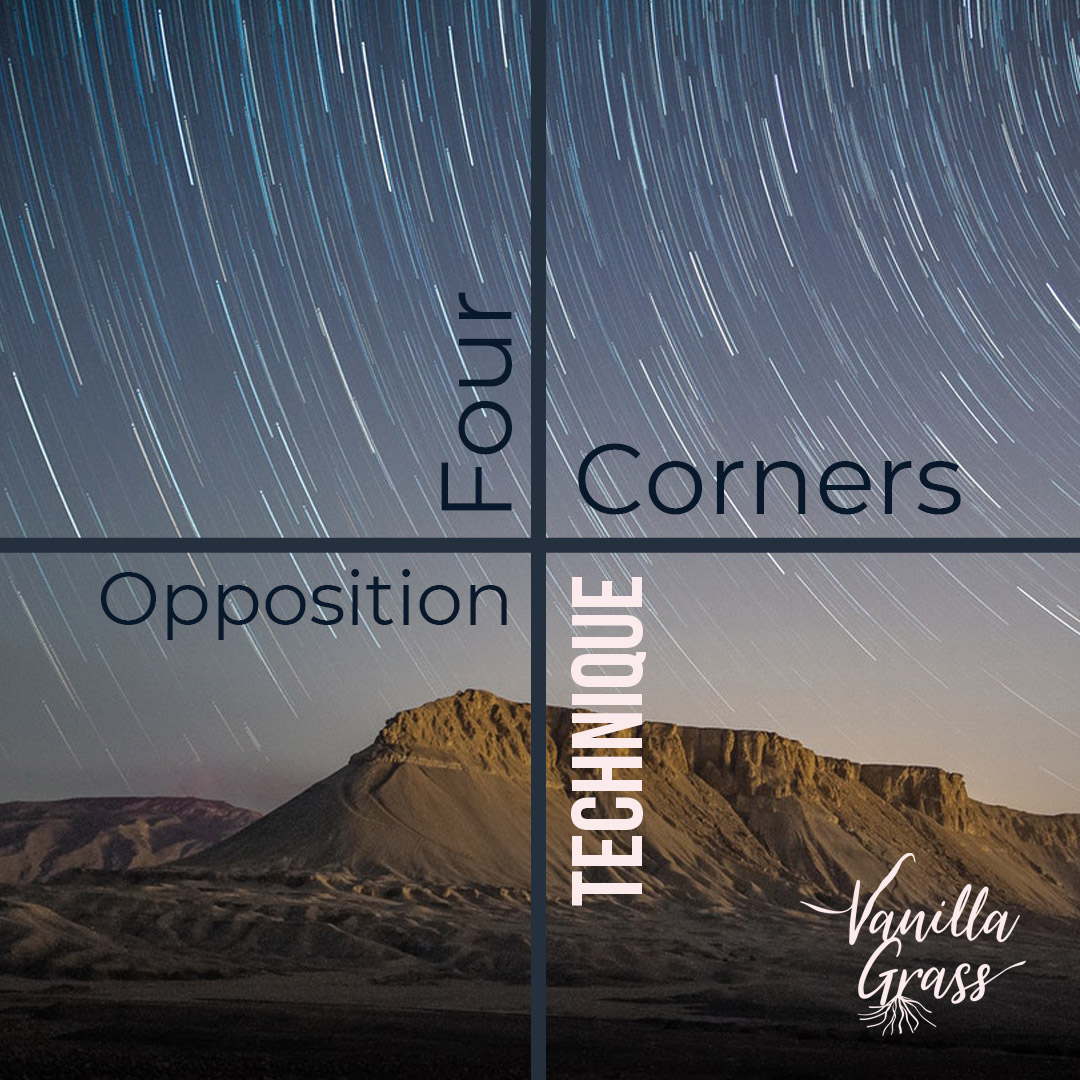Ready to use the 4 Corners of Opposition Technique to write a book that sells?
Are you in the trenches already and wondering how to create memorable character dynamics in your book?
Or are you taking a step back to look at the bigger picture, wondering how to choose a theme for your novel?
Whatever stage of the writing process you’re in, preparing your character dynamics can make an impactful difference in your story.
Why?
Because readers love dynamic characters. They love characters they can understand and sympathize with. They want to read about characters they love to hate.
So how do you create these reader-grabbing characters and put them into the theme of your book?
And how do you create a theme that best exemplifies each of the characters’ internal and external struggles?
In this post, we use the 4 Corners Opposition Technique to crack the secret to creating character dynamics that help you find the best theme for your book.

To do this, we first need to learn:
How to Create Effective Character Dynamics Using the 4 Corners Opposition Technique
For this, we’ll be using a spin-off of the 4 Corners Opposition Technique. Not sure what that is? No problem. Let’s take a look:
As you can guess by the name, the 4 Corners method kind of works like the schoolyard game, 4 Square. You have one character in each box who interacts with the other characters in their respective boxes. But instead of a ball, they’re passing dialogue, tension, conflict, and other relationship dynamics back and forth. And as they crisscross about, creating delicious drama, the theme forms in the center.
Here’s an example of what this looks like.
You have your 4 boxes with your 4 integral characters with the theme in the middle. Now, the point of the 4 Corners Opposition Technique is to have these characters interact in different ways based on their motives and desires.
After all, if all your characters wanted to achieve the same things and do so in the same ways, the story would be rather boring.
So let’s give our characters some complexity to help navigate how they relate to each other. The key to this part is creating tension.
Adding Character Motivation to the 4 Corners Technique
To start, let’s assign each of the characters a motivation. These motivations generally stem from strong feelings.
Some examples of character motivation are:
- Love / Hate
- Lust / Revulsion
- Revenge / Seeking Forgiveness
- Greed / Charity
- Envy / Pity
- Protectiveness / Over-Protectiveness
- Obligation / Fear of Commitment
- Inadequacy / Pride
- Virtue / Fear
Notice how I paired opposite emotions with each other?
That’s because the simplest 4 Corner setup is having two of the characters feel one way about something while having the other two feel the opposite. In the case below, we have two characters who love the house they all own together while the other two characters hate it.
Already, you can see lines of tension and conflict taking a rough shape between your characters.
Character 1 has an ally in Character 4 because they both love the house. Conversely, they are automatically at odds with Characters 2 and 3 because they hate the house Character 1 loves.
But that’s not enough to create a compelling story, is it?
Of course not!
The drama of a story comes in how each of the characters uses their motivation to act in the story. Just because two characters love something doesn’t mean they’ll act the same way towards it. That’s when things get exciting!
If you’d like a book example, check out The Pharaoh’s Curse. In this beautifully written novel, two of the main characters both fear and respect the power of Fate and end up at heads because how they feel, act, and are motivated create a push and pull between the characters.
Turning Motivation Into Intentions
For an example of this, let’s take a look:
By adding each character’s intended action (in this case, wanting to sell the house or not), we can begin to see the internal and external shape of the story’s conflicts and know which characters will be butting heads and about what.
The ally Character 1 thought they had in Character 4 turns out to be false. They may both love the house, but Character 4 wants to sell it when Character 1 wants to keep it. Instead, they find unlikely allies in Characters 2 and 3 who may hate the house but have matching intended actions.
Do you see the juicy story forming? Me too.
But are these shallow motivations and intended actions enough to write a great novel?
To write a simple story, sure. But to write a compelling, character-driven story, we’re still missing an important piece.
You may have noticed that some of the characters’ motivations and intended actions seem to contradict one another. This is where the deliciousness of complex characters comes in.
What would make someone who loves their house want to sell it? What would make someone who hates their house want to keep it?
The “Why” Behind Your Character’s Actions
The answer lies in the true desire of each character.
Or, in other words:
The real why of their motivation. Why does each character love or hate the house?
A lot of times, this inner desire or belief is called the false truth. In other words, it’s a belief the character uses as a measuring stick for everything they do. It’s also usually wrong in at least one way, which is why the character starts out doomed to fail and must change over time.
See the picture below where I added the inner reasoning (true desire or false truth) of each character that dictates their motivation.
See how their desires, motivations, and false truths are all closely linked? While you don’t have to match them up so succinctly, this is what is supposed to happen to create a good book.
And now, when we ask why someone who loves a house would sell it, like character 4, we can check their false truth. Character 4 believes that home is with a person, not a building. So, even if he loves the house, a person could make him want to sell. Maybe, he needs the money to pay medical bills for his mom, who he feels is his home. Or maybe, his true love is moving across the world, and he is willing to sell the house to be with her because she is his home.
The real why behind your character’s motivations and actions is the meat of the story; it is the missing ingredient that makes characters instantly relatable to readers and creates complex dynamics you couldn’t get in a book any other way.
Most importantly, it ties the whole story together.
So, if a character wants something completely different than everyone else and plans to achieve it in a way that affects no one else because their false truth is irrelevant to everyone else…they don’t belong in the story!
Using Dynamic Characters to Find a Book’s Theme
Now that we have established our characters and their motivations, intended actions, and false truths, and set up the dynamics between them all, what’s left?
What do all the best books have in them?
Theme.
If you’ve worked hard to make sure all the characters relate to the story and each other, you should be able to find the theme easily. The key is each character’s false truth. In the house example, each character has a false belief about what a home really is. To stay true to the character’s story arcs, the theme should address these false truths and center on the idea of home.
This could be done by writing a novel that proves one of the characters correct or terribly wrong. It could also examine that the world isn’t perfect and everyone’s a little right. Or maybe, the theme could propose that all the characters are wrong.
Just make sure that whichever way you choose to take it, the theme relates to all the pieces in the 4 Corners Opposition Technique.
And voila!
Of course, this could get a lot more complex depending on your characters and what you have in mind. But if you’re wondering how to prepare to write a book (or getting ready for NaNoWriMo!) this is a great place to start!
Also, attached below is a downloadable black-and-white version of the 4 Corners Character worksheet that you can fill in for yourself.
Once you have your characters set up to be mortal enemies and unlikely friends and have the theme of your book solidly in place, be sure to check out our post on how to start a book and character development so you can get writing!
Or are you brushing off the beautiful pages of a finished rough draft and wondering what to do next? Our awesome post on why you need alpha and beta readers is a great place to start, or you can check out our series of posts on developmental editing!
Enjoy! And keep writing!





I have a wordpress blog now, but I can’t figure out how to get readers into there! I have been using myspace and it’s been great, subscriptions like crazy, but a lot of them don’t have wordpress…so no leads there. Besides, I am posting the same info to both, so it’s not much of a point of them getting one. How can I increase my wordpress readership? I already utilize tags, but I still only got about 89 views in two weeks. . . . Thanks in advance–serious answers only, please!.